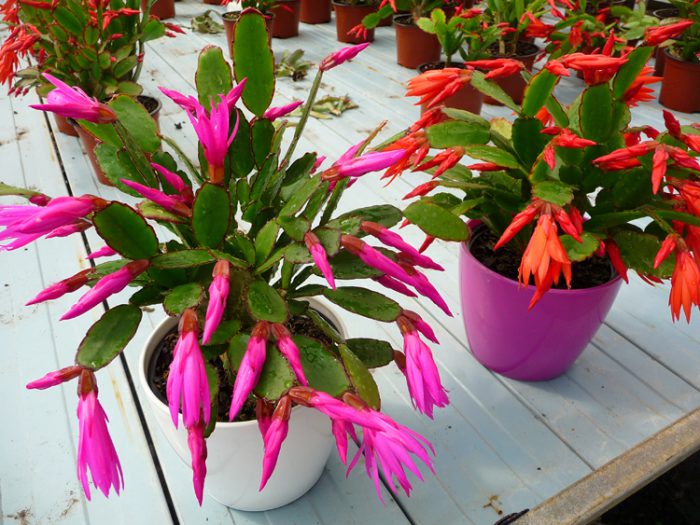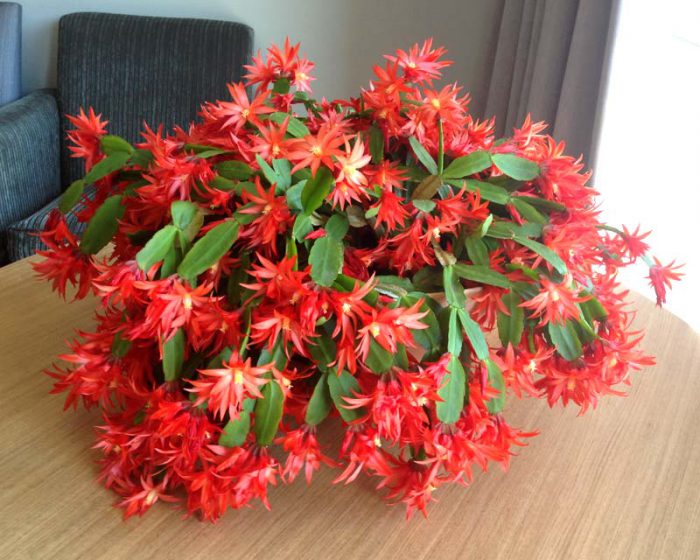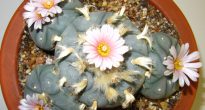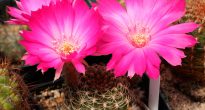Rhipsalidopsis (Rhipsalidopsis) is a not very large epiphytic evergreen shrub and is directly related to the cactaceae family (Cactaceae). In nature, it can be found in the tropical rainforests of South America.
Consisting of ribbed or flat segment segments that reach 4 to 6 centimeters in length and 3 centimeters in width, the shoots are branching and are colored light green. However, when exposed to bright sunlight, the stems sometimes acquire a reddish tint. The edges of the segments have smooth and almost invisible ridges. However, there are spines at the ends of the segments that are similar to thick bristles. At the tips of the segments, flowers are formed that open wide (up to 4 centimeters in diameter). 1-3 flowers emerge from the 1st areola. In different varieties, flowers can be colored in different ways, for example, these are all color shades from pink to white, as well as to dark red. When the plant fades, rather soft berries-fruits appear on it.
This plant has clear external similarities with schlumberger... But there are a few differences:
- in the structure of the segments - Ripsalidopsis has smoothed protrusions along the edges, and Schlumberger - segments, along the edges of which sharp teeth are located;
- in the form of flowers - the flowers of Ripsalidopsis have an even corolla, and they are radially symmetric, while Schlumberger's corollas are beveled;
- in bloom - Schlumberger blooms in winter and Ripsalidopsis in spring.
Ripsalidopsis care at home
Illumination
Needs good lighting, but at the same time it should be diffused. Recommended to be placed on windows with east or west orientation. In the warm season, you can take it outside, but you need to provide shading from direct sunlight.
Temperature regime
In summer, it needs moderate temperatures (18 to 20 degrees). In February – March, the plant needs coolness (about 10–12 degrees) to lay flower buds.
Humidity
Needs high humidity. Therefore, systematic spraying with soft water, which should be at room temperature, is recommended for Ripsalidopsis. To increase the humidity, you can place moistened moss or expanded clay in the pallet, but you must make sure that the bottom of the container does not come into contact with the liquid. When wintering cool, the plant is not sprayed.
How to water
In the spring and summer, water should be abundant.Watering is carried out after the topsoil dries out. With the onset of the autumn period, they begin to gradually reduce watering. And in winter, watering should be extremely moderate, especially during cold wintering.
Top dressing
During active growth, top dressing is done once every 2 weeks. For this, mineral fertilizers with a minimum amount of nitrogen are used, and you can also take fertilizers specially designed for cacti.
Earth mix
Suitable soil should be light, slightly acidic (pH 5 or 6), and good air permeability. To prepare the soil mixture, it is necessary to combine sod, deciduous and humus soil, sand and peat, taken in a ratio of 1: 6: 4: 2: 2.
Transplant features
The transplant is carried out after the cactus has faded. Young specimens are transplanted once a year, and adults - once every 2 or 3 years.
Reproduction methods
It can be propagated by grafting, stem cuttings, and seeds.
It is very easy to propagate stem cuttings. To do this, you need to separate 2 or 3 segments from the shoot with a rotational movement and leave in the open air for 2-3 days to dry. A stalk should be placed in a pot filled with a moistened substrate, but at the same time it does not need to be buried, but simply should be leaned against any support. The roots will quickly appear at the cuttings, and it can be planted in a soil mixture.
This plant can be grafted onto the stalk of the prickly thorny, and this procedure is recommended in the summer. It is necessary to cut off the branchy upper part at the pereskia with all the foliage, so that a bare stem remains. Its upper part must be carefully split. A shoot is taken as a scion, consisting of 2 or 3 segments, its end is sharpened (in the form of a wedge). With a pointed end, the shoot is inserted into the cleft. After that, you need to fix the vaccine and for this a thorn, a long thorn or a needle is suitable. And then it must be wrapped using a thread or plaster for this. Place the pot in a place with a temperature of about 18–20 degrees. The scion will grow together after half a month and after that it will begin to grow. After that, the bandage is removed, and as soon as branches or leaves appear in the lower part, they are immediately cut off. Such a plant differs in that it blooms very profusely.
Ripsalidopsis can be grown quite easily from seeds. To obtain them, you need two adult cacti, which are unrelated to each other (you can use different species or varieties). A brush is used to take pollen from the flowers of one specimen and transfer it to another. When flowering is over, the fruit will appear in the form of a reddish berry. The fruit ripens long enough and only after it shrivels, it can be plucked.
The seeds remain viable for several years. Sowing seeds is carried out in a wide pot, into which you need to pour an earth mixture, consisting of equal shares of leafy earth and sand. The grown seedlings are transplanted into pots. In this case, it is recommended to plant several seedlings in one pot (to obtain a more lush bush).
Pests and diseases
The plant can settle mealybugs, false shields, spider mites and scabbards.
Can get sick with bacterial or fungal infections.
At first, rot may appear in only one small area of the plant, while a slippery and damp spot is formed. Then the same spots appear on other parts of the cactus.
Antibacterial agents in this case are ineffective. It is recommended to carefully cut off the infected part of the cactus. If rot appears at the base of the stem, then the uninfected segments should be separated and then rooted.
In most cases, there are fungal diseases such as phytium, fusarium or late blight.
Fusarium infection can occur through holes left by pests or through wounds. To cure the plant, you will need a fungicide containing active ingredients such as benomyl and chlorothalonil.
With late blight or phytium, a cactus can get sick due to an infected substrate, and the root neck is most often affected. To understand that the plant is painful is quite simple. It withers, but the soil is moistened. Also, the color of the cactus can fade or become grayish. You will need treatment with a fungicide designed to combat fungal diseases.
Possible difficulties
- Falling flowers or segments - stagnant water in the ground, applied a lot of fertilizers, cold or dry air, moving a flower from place to place.
- Slow growth and lack of flowering - little light, improper maintenance during the dormant period, needs additional feeding.
- The segments become pale, a red tint may appear, as well as brownish spots - too intense illumination, burns by direct sunlight.
- The cactus withers, the shoots become drooping, and the base of the stem turns black - stagnant water in the soil (especially in winter when kept in a cool place).
Advice:
After the buds begin to appear and before the end of flowering, you should not rearrange or turn the pot. Otherwise, it can provoke bud fall. It is recommended to make a mark on the container in order to keep the orientation of the plant under control.
Video review
Main types
Rhipsalidopsis Gartner (Rhipsalidopsis gaertneri)
It is an epiphytic evergreen bushy cactus reaching a height of 15–20 centimeters. This plant can be hanging and creeping. It has flat glossy branching shoots of dark green color, which consist of many flat segments, reaching a length of 4 to 7 centimeters, and in diameter - from 2 to 2.5 centimeters. Along the edges of the segments, there are 3 to 5 rounded projections with pubescent areoles, as well as with 1 or 2 yellow-brown setae. Flowering begins in April or May. At this time, many flowers bloom on the end segments, reaching 4-8 centimeters in length and having a short tube and deep red petals.
Rhipsalidopsis rosea (Rhipsalidopsis rosea)
It is not a very large bushy evergreen cactus. Shoots consist of small ribbed or flat segments with serrated-crenate edges. Pink flowers reach 5 centimeters in diameter.


Watch this video on YouTube
















